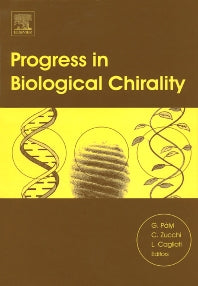Freshly Printed - allow 10 days lead
Couldn't load pickup availability
Progress in Biological Chirality
An excellent follow up to Advances in BioChirality
Gyula Palyi (Edited by), Claudia Zucchi (Edited by), Luciano Caglioti (Edited by)
9780080443966, Elsevier Science
Hardback, published 21 September 2004
444 pages
24 x 16.5 x 2.8 cm, 0.93 kg
"The book gives a many-sided and very concentrated up-to-date picture of biological chirality. This book offers broad information for interested specialists, as well as for scientists who are working actively at the border of stereo-chemistry and biological chemistry." --Vladik A. Avetisov, MENDELEEV COMMUNICATIONS, No. 6, 2004
Following on from Advances in BioChirality, Progress in Biological Chirality provides a unique summary and review of the most recent developments in the field of biochirality. Living organisms use only one enantiomer of chiral molecules in the majority of biologically important processes. The exact origin and mechanisms for this surprising selectivity are not yet known. This book discusses current research aimed at identifying the scientific reasons that may contribute to this phenomenon. Progress in Biological Chirality takes an interdisciplinary approach to this exciting field, covering a wide range of topics, such as, theory, palaeontology and food technology, to name but a few. This book presents findings via a broad spectrum of scientific approaches making it an excellent overview of Biological Chirality, suitable for postgraduate students, practitioners and researchers in the field of chemistry, biochemistry, biology, palaeontology, and food science with an interest in Chirality.
Origin of Biomacromolecular Chirality: In Search of Evolutional Dynamics.
Carbon Monoxide Clusters in the Formation of D-Sugars, L-Amino Acids, Ribonucleotides and Deoxyribonucleic Acids in Prebiotic Molecular Evolution on Earth.
Molecular Clockworks as Tools for Biological Chirality.
Diastereomers Do, What They Should Not.
Molecular Origins of Life: Homochirality as a Cosequence ot the Dynamic Co-Emergence and Co-Evolution of Peptides and Chemical Energetics.
Use of Amino Acids and Amino Acid Racemization for Age Determination in Archaeometry.
Enantiomeric Enrichment in Nonracemic Conglomerates. A Possible Component of the Solution to the Problem of the Origin of.
Genetic Code: Self Referential and Functional Model.
Specific Symmetry of Living Systems.
Chiral Crystal Faces of Common Rock-Forming Minerals.
Origin of Biomolecules - Origin of Homochirality.
Implication of Polya's Urn Experiment and Celebral Lateralization.
Theory of Hierarchical Homochirality.
Possible Mechanisms for Production of Larger Enantiomeric Excess.
Sugar C-Sulfonic Acids.
Racemization of Amino Acids in Hydrothermal Environments: a Contribution of Temperature Gradient.
The Theory of Chirality Induction and Chirality Reduction in Biomolecules.
The Theory of Chirality Induction and Chirality Reduction in Biomolecules.
Transfer of the Chiral Information of Natural Amino Acids in Biomimetic Organic Syntheses.
CD and Visual Science.
Volatile Components of Food Aroma: Biosynthesis and Biotransformations.
Chiral Spaces in Encapsulation Complexes.
Serum Albumin and Natural Products.
Chiral Spaces in Encapsulation Complexes.
Selection in the Model Process of Prebiotic Synthesis of RNA Using Metal Ion Catalyst and Template.
Different Internal Gradients for L and D Homochiral Solutions in Homogeneous Magnetic Fields.
Tryptophanase Activity on D-Tryptophan.
Deviation from Physical Identity Between D- and L-tyrosine.
Occurence of D-Amino Acids in Food.
Asymmetric Autocatalysis, Absolute Asymmetric Synthesis and Origin of Homochirality of Biomolecules.
Deviation from Chemical Identity Between D and L Tyrosine?
Charophyte Gyrogonites, the Result of Enantioselective Influence 250 Million Years Ago.
Chirality Transfer in the Formation of the Indole Alkaloids Derived from Secologanin.
Subject Areas: Molecular biology [PSD], Biochemistry [PSB], Chemistry [PN]


